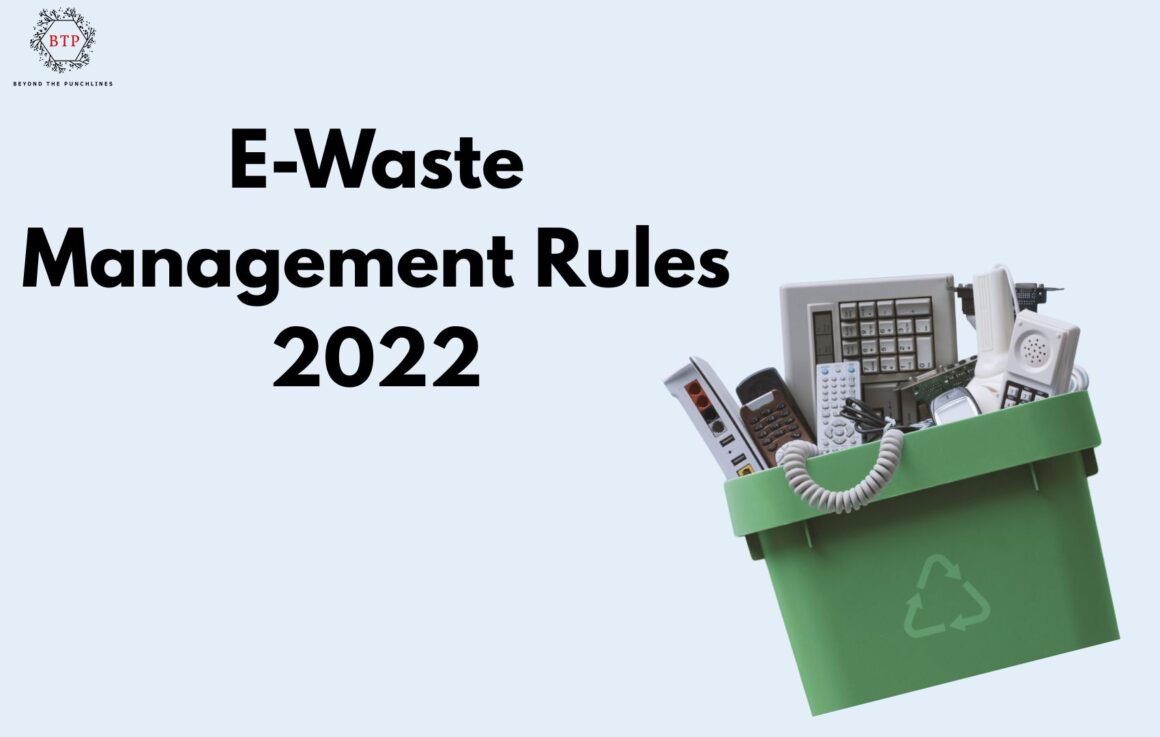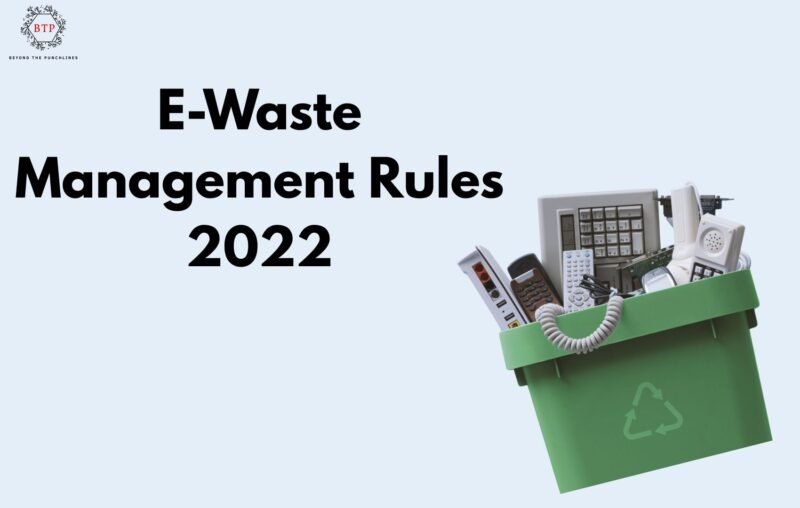
E-Waste Management Rules 2022 were first introduced in 2011 in India and were implemented in 2012. These rules applied to manufacturers only, but then in 2016, a new set of rules was introduced, which expanded the scope of applicable rules to bulk consumers, refurbishers of recycled and dismantlers.
These new rules establish a more comprehensive, transparent, and accountable system for managing electronic waste, emphasising Extended Producer Responsibility (EPR), recycling, and digital compliance mechanisms.
E-Waste Management Rules 2022: Background and Need for the 2022 Rules
Prior to 2022, India operated under the E-Waste Management Rules, 2016, which focused on authorizations, collection targets, and responsibilities for producers and recyclers. However, as technology evolved, new product categories emerged, and waste volumes grew exponentially. The 2016 framework lacked mechanisms to ensure data integrity, traceability, and robust enforcement.
The E-Waste Management Rules 2022 were designed to address these issues by simplifying compliance, introducing a market-based EPR certificate mechanism, and bringing more accountability to producers, recyclers, and refurbishers.
Key objectives include: E-Waste Management Rules 2022,
- Strengthening the Extended Producer Responsibility (EPR) framework.
- Enhancing traceability through a centralized online portal.
- Ensuring environmentally sound recycling and disposal practices.
Scope and Applicability
The E-Waste Management Rules 2022 apply to all manufacturers, producers, refurbishers, dismantlers, and recyclers involved in the manufacture, sale, transfer, purchase, processing, or recycling of electronic and electrical equipment (EEE) and their components, consumables, spares, and parts.
Included under the E-Waste Management Rules 2022
- All products listed under Schedule I, which now covers over 100 categories of EEE.
- Solar photovoltaic (PV) modules/panels/cells, a new addition under the 2022 framework.
Excluded from the Rules:
- Waste batteries (covered under the Battery Waste Management Rules, 2022)
- Packaging plastics (regulated by the Plastic Waste Management Rules, 2016)
- Micro enterprises (under the MSME Act, 2006)
- Radioactive wastes (under the Atomic Energy Act, 1962)
Key Features and Innovations of the E-Waste Management Rules 2022
| Aspect | 2016 Rules | 2022 Rules |
|---|---|---|
| Scope of Equipment | 21 categories of EEE | Over 100 categories, including solar panels |
| Authorization System | Required authorization from SPCB/CPCB | Replaced by online registration via CPCB portal |
| EPR Mechanism | Producers managed their own collection | EPR Certificates introduced for credit-based compliance |
| Refurbishing | No clear provisions | Refurbishing Certificates allow deferred EPR obligations |
| Penalty Structure | Limited to violations under the Environment Act | Adds Environmental Compensation (EC) for non-compliance |
| Bulk Consumers | Required to maintain records | Simplified to only ensure proper disposal via registered entities |
Extended Producer Responsibility (EPR) Explained
EPR is the cornerstone of the E-Waste Management Rules 2022. It mandates producers to ensure environmentally sound management of e-waste generated from their products.
EPR Certificate System:
- Registered recyclers generate EPR Certificates based on the amount of e-waste they recycle.
- Producers purchase these certificates to meet their annual EPR targets.
- Refurbishers can issue Refurbishing Certificates, deferring some of the producers’ EPR obligations.
Annual Recycling Targets:
- 60% for 2023–24 and 2024–25
- 70% for 2025–26 and 2026–27
- 80% from 2027–28 onward
This credit-based approach promotes transparency and encourages private investment in the recycling sector.
Roles and Responsibilities of Stakeholders
1. Producers and Manufacturers:
- Register with the CPCB EPR Portal.
- Develop and submit EPR plans.
- Meet annual recycling obligations via EPR certificates.
- Ensure products comply with Restriction of Hazardous Substances (RoHS) norms.
- File annual returns and reports through the CPCB portal.
2. Recyclers and Dismantlers:
- Obtain registration and necessary consents under environmental laws.
- Generate EPR certificates based on actual recycled quantities.
- Maintain detailed records and allow audits by CPCB/SPCB.
3. Refurbishers:
- Register and issue refurbishing certificates.
- Maintain life-extension data of refurbished equipment.
4. Bulk Consumers:
- Must hand over e-waste only to registered recyclers or producers.
- Reduced compliance burden compared to earlier rules.
5. CPCB and SPCBs:
- CPCB: Operates the national EPR portal, verifies data, monitors compliance, and imposes penalties.
- SPCBs: Conduct inspections, grant consent to operate, and monitor local compliance.
Environmental Compensation (EC)
To ensure accountability, the E-Waste Management Rules 2022 introduce the Environmental Compensation (EC) mechanism. It imposes financial penalties on violators for:
- Operating without registration.
- False or misleading reporting.
- Failure to meet EPR targets.
- Dealing with unregistered entities.
EC amounts are calculated based on the cost of collection, transportation, and safe recycling of the unfulfilled quantity.
E-Waste Management Rules 2022: Challenges in Implementation
Despite its progressive approach, the new framework faces certain challenges:
- Limited Recycling Infrastructure: Many regions lack formal recycling capacity.
- Informal Sector Dominance: Over 90% of India’s e-waste is processed by the informal sector using unsafe methods.
- Compliance Costs: Small producers and recyclers face high registration and audit costs.
- Data Integrity: Ensuring accurate data and preventing fake EPR certificates.
- Awareness Gaps: Low consumer awareness about safe e-waste disposal practices.
Global Context and India’s Position
Compared to the EU’s Waste Electrical and Electronic Equipment (WEEE) Directive, India’s 2022 framework is still evolving but moves toward international best practices. The introduction of EPR credits, refurbishing provisions, and digital compliance portals are steps toward achieving circular economy goals.
The E-Waste Management Rules 2022 represent a major policy leap in India’s sustainability journey. By focusing on accountability, digital traceability, and shared responsibility, green jobs can be achieved. However, success depends on robust enforcement, data transparency, and effective integration of informal recyclers into the formal system.
The E-Waste Management Rules 2022 are not just an environmental regulation — they are a blueprint for a circular economy that turns waste into opportunity and responsibility into progress.
FOR MORE BLOGS – beyondthepunchlines.com

 Add to favorites
Add to favorites








